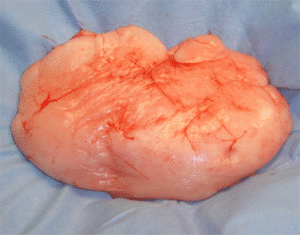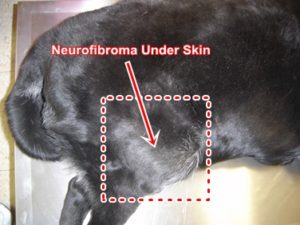Neoplasia (Cancer)
CLICK ON A TOPIC BELOW TO LEARN MORE
Adrenal Gland Tumors
The adrenal glands are small organs that lie near the kidneys and each consists of 2 major portions: the cortex (outer area)and medulla (middle area). The glands produce hormones that perform many essential tasks (eg. adrenal cortex: glucocorticoids, sex hormones; adrenal medulla: mineralcorticoids, catecholamines). Tumors of the adrenal glands, whether benign or malignant, cause an overproduction of these hormones. Signs of adrenal gland tumors may include excessive thirst, increased urination, hair loss, an enlarged or sagging abdomen, reduced stamina and progressive deterioration of general health. Diagnosis is afforded via physical exam, complete blood count, blood chemistries, laboratory tests (eg. ACTH stimulation, dexamethasone suppression, etc.) and imaging studies. Treatment may include medical management and/or surgery.
Bone Tumors
Bone tumors may be benign (non-cancerous) or malignant (cancerous). Benign tumors do not spread to other parts of the body and are less dangerous than malignant tumors which can spread locally or to distant parts of the body. Most bone tumors are cancerous and are usually painful. Signs may include pain, lameness and swelling. Diagnosis is via physical exam, radiography and biopsy. Treatment may include surgery, radiation therapy and chemotherapy. Prompt decision for surgery is required to relieve discomfort and to increase the chances for a successful outcome.
Eyelid Tumors
Eyelid tumors can be benign (non-cancerous) or malignant (cancerous). False tumors (granulomas) caused by inflammation may also occur. Most eyelid tumors are benign; however, it may be difficult to distinguish between the 2 types unless the tissue is examined microscopically via biopsy. Eyelid tumors that grow on the inner aspect of the eyelid may rub the eyeball and cause pain and damage to the eye. Signs associated with the eyelid tumors may include tearing, redness, eye discoloration, excessive blinking and pain. Diagnosis is afforded by ocular exam and biopsy. Eyelids tumor should be removed. Eyelid tumors may grow so much to necessitate a large section of eyelid tissue be removed to completely eliminate the entire tumor. In those cases, eyelid reconstruction (plastic surgery) may be required to retain proper eyelid function. Removal of eyelid tumors in their early stages helps avoid the need for extensive surgery and improves the pet’s prognosis.
Fibromatous Epulis
Fbromatous epulis is the most common benign (non-cancerous) oral tumor of pets. They are firm, pink tumors of the gums, most common in dogs over 8 years of age. Signs may include nodule formation, pain or lack of pain and possible redness. Diagnosis is by oral exam and biopsy. Treatment is surgical removal.
Fibrosarcoma
Fibrosarcoma is a malignant mesenchymal (connective tissue) neoplasia. The cause of this tumor is unknown but has been associated with subcutaneous injections in cats. Clinical signs include the appearance of a firm mass (fibroma) and/or discomfort. Diagnosis is afforded via physical exam and histopathology. Treatment is very wide surgical excision at the earliest sign of the disease.
Histiocytomas
Histiocytomas are common skin tumors in dogs but rare in cats. They are benign (non-cancerous) and usually affect younger pets. Histiocytomas may be button-shaped, ulcerated, less than 2 cm in diameter and located on the head, face, ears and/or legs. Diagnosis is afforded via physical exam and cytology or biopsy. Treatment may include surgery or neglect (many of these tumors regress on their own).
Insulinomas
Insulinomas are rare tumors of the pancreas that release excessive amounts of insulin and cause severe decreases in blood sugar (glucose) levels. Low blood sugar levels cause abnormal brain activity, ataxia, muscle twitching, weakness, collapse, blindness, depression, seizures and death. Diagnosis is afforded via physical exam, blood chemistries and imaging studies. Treatment includes surgery and supportive care.
Lipomas/Liposarcomas (fatty tumors)
Lipomas are benign (non-cancerous) fatty tumors. They are generally slow-growing soft, round, smooth, movable masses under the skin. Liposarcomas are cancerous fatty tumors that tend to invade other tissues. Diagnosis is via physical exam, cytology and biopsy. Treatment is surgical removal.


Malignant Lymphomas
Malignant lymphoma is a cancer of the lymphatic system. The disease may involve blood cells, lymph nodes, spleen, digestive tract or bone marrow. The disease is progressive and eventually fatal. Signs include inappetence, weight loss, excessive thirst and urination, lethargy and weakness. Diagnosis is afforded via physical exam, complete blood count, blood chemistries, fine needle aspirate and cytology, biopsy and bone marrow cytology. Treatment is chemotherapy combined with surgical removal of accessible tumors. The goal of treatment is to control progression of the disease and extend quality life as long as possible with a few undesirable side effects.
Mammary Tumors
Mammary tumors are common in both older dogs and cats. About 50% are malignant in dogs while over 90% are malignant in cats! Pets spayed before their first heat cycle are virtually spared this life threatening disease. Signs include mammary enlargement but may include discharge and even ulceration. Diagnosis is afforded via physical exam and biopsy. Treatment includes surgery, supportive care and possible adjunct chemotherapy.
Mast Cell Tumors
Mast cells are a normal component of the immune system and an important part of the inflammatory reaction. Mast cell tumors occur in both dogs and cats and may be either benign malignant. Their cause is unknown but occur more frequently in middle-aged Boxers, Boston Terriers, English Bulldogs, Bull Terriers, Labrador Retrievers, Dachshunds, Fox Terriers and Weimaraners than in other breeds. Most mast cell tumors occur on the skin as well defined, raised nodules although cats can have a large percentage occur internally. Signs vary on location of the tumor. Diagnosis is afforded via physical exam, complete blood count, cytology and biopsy. Treatment includes presurgical medication, surgery, radiation therapy and chemotherapy.
Neoplasia
Neoplasia means “new growth”. Neoplastic growths are referred to as tumors. All tumors are not life threatening and therefore it is necessary to determine whether the pet’s tumor is benign (non-cancerous) or malignant (cancerous). Exact causes of tumors may not be known but some factors that have a role in tumor formation include viruses, parasites, irradiation (sunlight, x-rays), hormones, genetic predisposition, and some chemicals. Benign (non-cancerous) tumors do not spread to other parts of the body while malignant (cancerous) tumors can spread or locally invade surrounding tissue. Microscopic examination of a tissue sample (biopsy) can determine whether the tumor is benign or malignant. Physical examination, laboratory tests, complete blood count, blood chemistries and radiographs (x-rays) or other imaging modalities may be used to determine the pet’s condition overall condition and best protocol for treatment.
Neurofibroma
Neurofibroma is a benign nerve sheath tumor of the peripheral nervous system. The mass arises from mesenchymal cells. There is no known cause of the tumor in pets. Signs of neurofibroma include appearance of a firm, usually lobulated mass, most commonly found on the limbs, pain, ataxia and/or lameness. Diagnosis is afforded via physical exam and microscopic evaluation. Treatment for the mass is surgical resection. Un fortunately, complete excision of the mass is difficult without complete removal of the affected area (eg. an entire limb) due to microscopic extensions of the neoplasm. This results in recurrence of the mass in most patients. The malignant component of this tumor is a neurofibrosarcoma.


Oral Papillomatosis
Oral papillomatois is a contagious viral disease that produces multiple growths or warts in the mouth, on the tongue, lips, eyelids or nose of young dogs. The growths appear 1-2 months after contracting the virus. Warts are pinkish cauliflower-like nodules Generally they are benign and self limiting. Signs may include halitosis, excessive salivation, reluctance to eat and bleeding from the mouth. Diagnosis is afforded via history, physical exam and biopsy. Treatment is usually surgery.
Papillomas
Papillomas are benign wart-like growths commonly found on the skin of older dogs. Diagnosis is via physical exam and biopsy. Treatment is surgical removal. Surgery is usually recommended if the papilloma is repeatedly traumatized or cosmetically unacceptable. The age and general health of the dog should be considered in deciding whether to perform surgery that requires general anesthesia.
Perianal Adenoma
Perianal adenomas arise from the small glands present in the anal area. They are most common in older male dogs. Tumor development is driven by male hormone. The tumor usually presents as a lump under the skin close to the anus or on the underside of the tail. Multiple tumors may be present which may be raw or bleeding. Diagnosis is via physical exam and biopsy. Treatment is surgical removal with concurrent castration of intact males.
Polyps
A polyp is a growth from the lining of an organ, tract or body cavity. Common sites include the throat, rectum, vagina and bladder. Most polyps are benign and can be single or multiple. Diagnosis is afforded via physical exam, imaging studies, endoscopy and biopsy. Treatment is surgical removal.
Prostatic Tumors
The prostate gland surrounds the tubular opening of the urinary bladder and produces seminal fluid. Tumors of the prostate are not common and can be either benign or malignant. Signs may include difficult urination, difficult bowel movement, soreness walking, bloody urine and/or blood dripping from the prepuce. Diagnosis is afforded via physical exam, imaging studies, urinalysis, cytology of prostatic fluid and biopsy. As with all other tumors, early detection is important for successful treatment especially since malignant prostate tumors often spread to nearby lymph nodes, kidneys and lungs. Treatment may include radiation therapy, surgery, hormone therapy and castration if necessary.
Reproductive Tract Tumors in Females
Tumors of the ovaries, oviducts, uterus and vagina are uncommon. Signs include masses within the abdominal cavity, abnormal cycling, abnormal vaginal discharges, or abnormal bulging of the genital area. Diagnosis is afforded via physical examination, imaging studies, laboratory tests and exploratory surgery. Treatment may include surgery, chemotherapy, radiation therapy and supportive care.
Sertoli Cell Tumors
Sertoli cell tumors are a neoplasia of the testicle generally occuring in male dogs over 5 years of age, but occasionally are found in younger dogs. The tumors occur more frequently in non-descended (cryptorcid) testicles. Sertoli-cell tumors produce estrogen (female hormones) in about 15% of the tumors in normal testicles, 50% of the tumors in testicles located in the groin, and 70% of the tumors in testicles located in the abdomen. Estrogens cause the development of female characteristics, such as enlarged mammary glands, swollen skin enclosing the penis, localized hair thinning, reduced penis size and sexually attraction to other male dogs. Diagnosis is afforded via physical exam, laboratory tests, ultrasound and biopsy. Treatment is surgical removal (castration).
Splenic Tumors
The spleen is a long, flattened vascular organ in the abdominal cavity which stores blood, makes new blood cells, destroys old blood cells and is a part of the immune system. The spleen is not essential to life and can be removed if a tumor is present. Signs of splenic tumors may include anemia, abdominal enlargement or no outward signs. The tumors can be benign or malignant. Diagnosis is afforded via physical exam, complete blood count, cytology, imaging studies, exploratory surgery and biopsy. Treatment is surgical removal of the spleen.
Transmissible Venereal Tumors
Transmissible venereal tumors (TVT) occur in young male and female sexually active dogs. In males they are found on the penis and/or prepuce and in females they occur on the vulva and/or vagina. They may also be found on the face or legs of either sex and can be single or multiple. The tumors are transmitted during sexual intercourse as well as via licking, biting and other contact. Signs may include bleeding from the genitals or visible growths. Diagnosis is afforded via physical exam and cytology. Treatment may include surgical excision, radiation and/or chemotherapy.
Urinary Tract Tumors
The urinary tract includes the kidneys, ureters, urinary bladder and urethra. Tumors, benign or malignant, may originate within the urinary tract or may develop elsewhere in the body and spread to the urinary tract. Signs of urinary tumors include dark or bloody urine, straining to urinate, frequent urination, vomiting, depression and a distended abdomen. Diagnosis is afforded via physical exam, complete blood count, blood chemistries, urinalysis, imaging studies and biopsy. Treatment may include surgery, radiation and chemotherapy.











